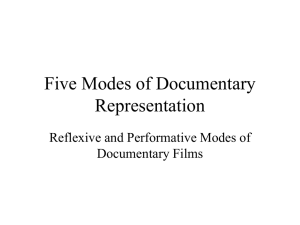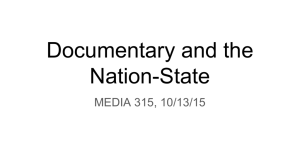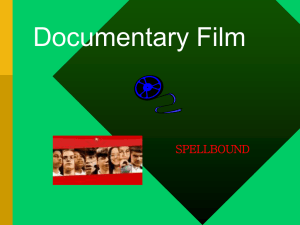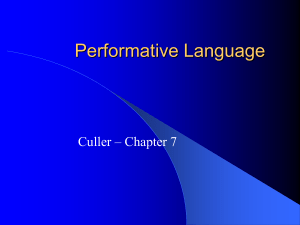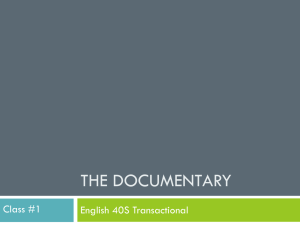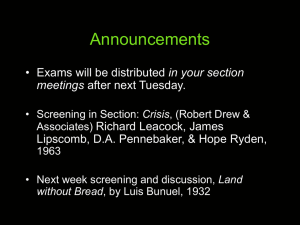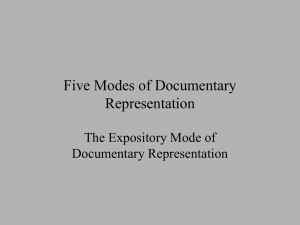Five Modes of Documentary Representation
advertisement
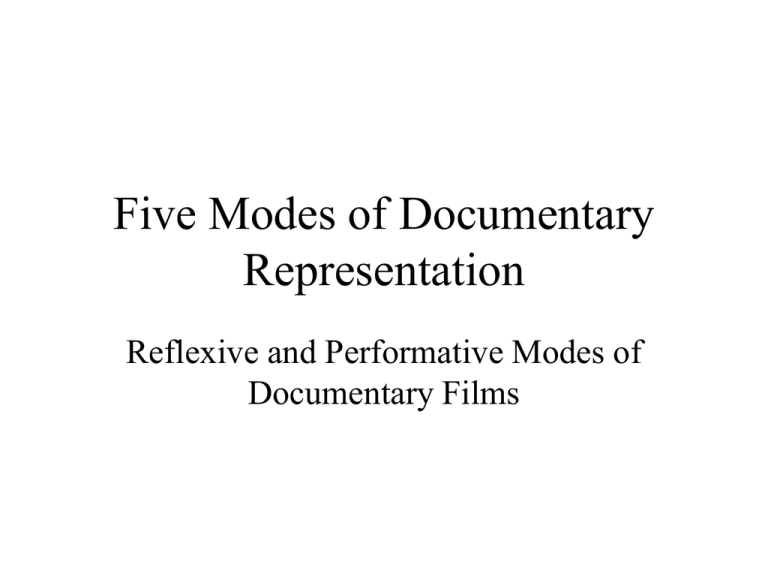
Five Modes of Documentary Representation Reflexive and Performative Modes of Documentary Films Table of Contents 1) Reflexive Mode of Documentary Representation 2) Dziga Vertov and Man with a Movie Camera 3) Performative Mode of Documentary Representation 4) Chris Maker’s Sans soleil Reflecxive Mode • Reflexive documentary arose from a desire to make the conventions of representations themselves more apparent and to challenge the impression of reality which the other three modes normally conveyed unproblematically. Bill Nichols, Representing Reality, p. 33 Reflexive Mode • To problematize the ways in which documentaries reveal the truth • Reflexive documentaries are about documentaries and documentary representation Dziga Vertov • Dziga Vertov (18961954) psychoneurologist, film editor, director and theorist • Formation of the group of filmmakers called ‘Kinok’ (or ‘Kino-oki’) = camera eye Dziga Vertov • Vertov and ‘Kino-oki’ abandons fiction film for documentary. • The camera can capture lifeas-it-is which is missed by human eye. • The film drama is the Opium of the people… down with Bourgeois fairy-tale scenarios… long live life as it is! Dziga Vertov • Belief in the primacy of movie camera over human eye - To be able to see at long distances, to film in slow or fast motion, etc - Through editing, scenes from different times and places could be cut together, the same scene viewed from several different angles, impressions of speed and energy enhanced by fast cutting Dziga Vertov • Kinok (Kino-oki) presents a reality which only a movies can presents. • The reality different from the reality the audience experiences. • At the same time, it poses a question: the reality captured in documentary films is different from the reality that we experience. Dziga Vertov • Our eyes see very little and very badly – so people dreamed up the microscope to let them see invisible phenomena; they invented the telescope… now they have perfected the cinecamera to penetrate more deeply into the visible world, to explore and record visual phenomena so that what is happening now, which will have to be taken account of in the future, is not forgotten.—Provisional Instructions to KinoEye Groups, Dziga Vertov, 1926 Dziga Vertov • Man with a Movie Camera (1929) presents urban lives in Soviet cities. From dusk to dawn Soviet citizens are shown at work and at play. • Also, it is about filmmaking Dziga Vertov • Showing the viewer how a film is made • Double exposure • Quick motion • Slow motion • Stop motion • Tracking shot • Extreme high and low angles • Unusual camera movement Dziga Vertov Legacy • Self-reflexivity - the documentary shows how itself is created. → Film’s reflection on itself • Jean-Luc Godard and other nouvelle vague filmmakers Legacy • Films showing the viewer filmmaking processes • Chris Marker • Stan Brakhage Mothlight Self-reflexive Cinema • François Truffaut’s La Nuit Americaine (Day for Night, 1973) • Definitive film on filmmaking • Film within a film: La Nuit Americaine is constructed around the production of Je vous presente, Pamela. Performative Mode • [Performative documentaries] stress subjective aspects of a classically objective discourse - possible limitations: loss of referential emphasis may relegate such films to the avant-garde; 'excessive' use of style. Bill Nichols, Blurred Boundaries, p. 95 Performative Mode • The priority - to evoke the MOOD or ATMOSPHERE. • Aims - to present reality in a subjective, expressive, stylised, evocative and visceral manner. Performative Mode • Harry Watt and Basil Wright, Night Mail (1936) about the mail carried from London to Edinburgh in an express train • Poems written by W.H. Auden and Music by Benjamin Britten Performative Mode • Alain Resnais’s Nuit et Brouillard (Night and Fog, 1955) • One of the first documentary on the horror of the Holocaust. Performative Mode • Contrast between the huge stillness of the abandoned camps and horrific wartime footage. • Text by Jean Cayrol and spoken by Michel Bouquet Performative Mode • Chris Maker, Sans soleil (1983) • Meditations on travel, memory (or forgetting), and time in words and images. Performative Mode • An essay, a collage mixing images with philosophical comments, and creating an atmosphere of dream.
